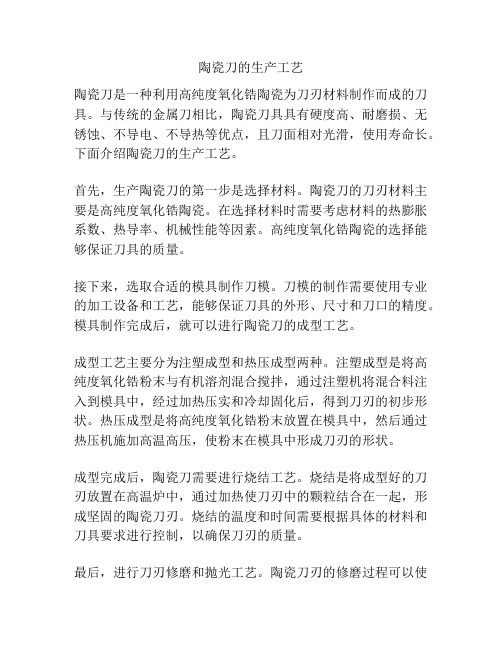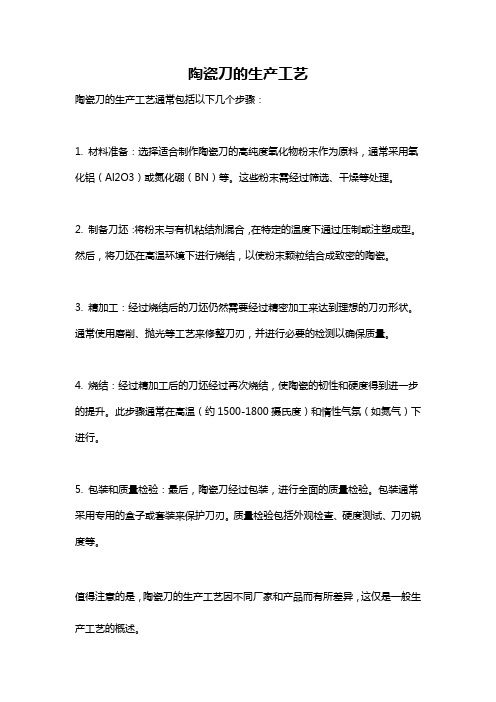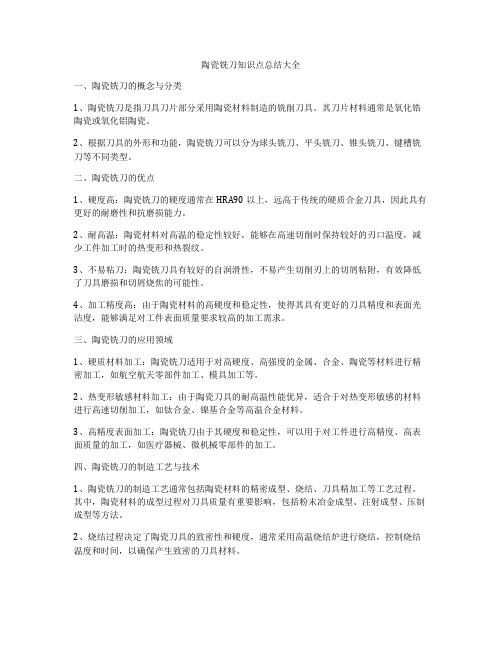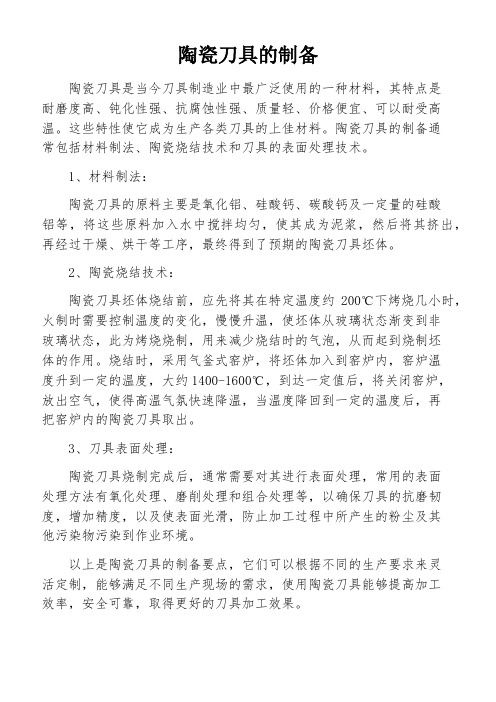陶瓷刀工艺
陶瓷刀的生产工艺

陶瓷刀的生产工艺陶瓷刀是一种利用高纯度氧化锆陶瓷为刀刃材料制作而成的刀具。
与传统的金属刀相比,陶瓷刀具具有硬度高、耐磨损、无锈蚀、不导电、不导热等优点,且刀面相对光滑,使用寿命长。
下面介绍陶瓷刀的生产工艺。
首先,生产陶瓷刀的第一步是选择材料。
陶瓷刀的刀刃材料主要是高纯度氧化锆陶瓷。
在选择材料时需要考虑材料的热膨胀系数、热导率、机械性能等因素。
高纯度氧化锆陶瓷的选择能够保证刀具的质量。
接下来,选取合适的模具制作刀模。
刀模的制作需要使用专业的加工设备和工艺,能够保证刀具的外形、尺寸和刀口的精度。
模具制作完成后,就可以进行陶瓷刀的成型工艺。
成型工艺主要分为注塑成型和热压成型两种。
注塑成型是将高纯度氧化锆粉末与有机溶剂混合搅拌,通过注塑机将混合料注入到模具中,经过加热压实和冷却固化后,得到刀刃的初步形状。
热压成型是将高纯度氧化锆粉末放置在模具中,然后通过热压机施加高温高压,使粉末在模具中形成刀刃的形状。
成型完成后,陶瓷刀需要进行烧结工艺。
烧结是将成型好的刀刃放置在高温炉中,通过加热使刀刃中的颗粒结合在一起,形成坚固的陶瓷刀刃。
烧结的温度和时间需要根据具体的材料和刀具要求进行控制,以确保刀刃的质量。
最后,进行刀刃修磨和抛光工艺。
陶瓷刀刃的修磨过程可以使用专业的磨料和磨具进行,以去除刀刃上的毛刺和不平整的地方,使刀刃更加光滑锋利。
抛光则是利用抛光机进行,可以使刀刃表面更加亮丽平滑。
通过以上的工艺流程,陶瓷刀便可以制作完成。
在实际生产过程中,还需要进行质量检查和检验,以确保刀具的质量和性能符合要求。
陶瓷刀具广泛应用于食品加工、医疗器械、电子元器件等领域,成为一种受欢迎的刀具选择。
陶瓷刀生产流程

陶瓷刀虽然也有“陶瓷”二字,但其生产流程却与普通的日用陶瓷大不相同,在原料上,它不同于普通陶瓷餐具使用石英等材料,而是用高科技纳米材料“氧化锆”高温烧制而成,工艺繁复,制成一把我们爱不释手的陶瓷刀一般要完成以下将近10个步骤:
1、将水、氧化锆粉末等材料装入搅拌机搅拌均匀
2、经过过滤筛选,只有那些直径一致,大小不超过1微米的纳米级的原料颗粒才能进入下一个步骤
3、经过喷雾,干燥,脱水,造粒等流程将上面的原料制成颗粒状粉末
4、接着再将上面所制成的粉末在刀形磨具上进行填充
5、使用压机,对模具中的粉末进行加压,其压力是大约每平方厘米12900磅,只有这样的重压才能使粉末固定成刀形
6、将已固定成刀形的粉末放入窑中进行烧制,陶瓷刀的烧制温度要高达2000度,对比普通陶瓷来说是高得多的
7、在烧结过程中刀片将会出现萎缩的状况,萎缩的幅度达到75%到50%不等,这就要求陶瓷刀磨具设计者在设计时要注意到这一点
8、烧制完毕的陶瓷刀坯出炉后还要使用金刚石砂轮等设备对刀片表面进行加工并开出刀刃
9、刀刃开好,加工完毕之后,只要再为它装上刀柄一把高贵典雅的“贵族刀”变宣告完成了。
陶瓷刀的生产工艺

陶瓷刀的生产工艺
陶瓷刀的生产工艺通常包括以下几个步骤:
1. 材料准备:选择适合制作陶瓷刀的高纯度氧化物粉末作为原料,通常采用氧化铝(Al2O3)或氮化硼(BN)等。
这些粉末需经过筛选、干燥等处理。
2. 制备刀坯:将粉末与有机粘结剂混合,在特定的温度下通过压制或注塑成型。
然后,将刀坯在高温环境下进行烧结,以使粉末颗粒结合成致密的陶瓷。
3. 精加工:经过烧结后的刀坯仍然需要经过精密加工来达到理想的刀刃形状。
通常使用磨削、抛光等工艺来修整刀刃,并进行必要的检测以确保质量。
4. 烧结:经过精加工后的刀坯经过再次烧结,使陶瓷的韧性和硬度得到进一步的提升。
此步骤通常在高温(约1500-1800摄氏度)和惰性气氛(如氮气)下进行。
5. 包装和质量检验:最后,陶瓷刀经过包装,进行全面的质量检验。
包装通常采用专用的盒子或套装来保护刀刃。
质量检验包括外观检查、硬度测试、刀刃锐度等。
值得注意的是,陶瓷刀的生产工艺因不同厂家和产品而有所差异,这仅是一般生产工艺的概述。
陶瓷铣刀知识点总结大全

陶瓷铣刀知识点总结大全一、陶瓷铣刀的概念与分类1、陶瓷铣刀是指刀具刀片部分采用陶瓷材料制造的铣削刀具。
其刀片材料通常是氧化锆陶瓷或氧化铝陶瓷。
2、根据刀具的外形和功能,陶瓷铣刀可以分为球头铣刀、平头铣刀、锥头铣刀、键槽铣刀等不同类型。
二、陶瓷铣刀的优点1、硬度高:陶瓷铣刀的硬度通常在HRA90以上,远高于传统的硬质合金刀具,因此具有更好的耐磨性和抗磨损能力。
2、耐高温:陶瓷材料对高温的稳定性较好,能够在高速切削时保持较好的刃口温度,减少工件加工时的热变形和热裂纹。
3、不易粘刀:陶瓷铣刀具有较好的自润滑性,不易产生切削刃上的切屑粘附,有效降低了刀具磨损和切屑烧焦的可能性。
4、加工精度高:由于陶瓷材料的高硬度和稳定性,使得其具有更好的刀具精度和表面光洁度,能够满足对工件表面质量要求较高的加工需求。
三、陶瓷铣刀的应用领域1、硬质材料加工:陶瓷铣刀适用于对高硬度、高强度的金属、合金、陶瓷等材料进行精密加工,如航空航天零部件加工、模具加工等。
2、热变形敏感材料加工:由于陶瓷刀具的耐高温性能优异,适合于对热变形敏感的材料进行高速切削加工,如钛合金、镍基合金等高温合金材料。
3、高精度表面加工:陶瓷铣刀由于其硬度和稳定性,可以用于对工件进行高精度、高表面质量的加工,如医疗器械、微机械零部件的加工。
四、陶瓷铣刀的制造工艺与技术1、陶瓷铣刀的制造工艺通常包括陶瓷材料的精密成型、烧结、刀具精加工等工艺过程。
其中,陶瓷材料的成型过程对刀具质量有重要影响,包括粉末冶金成型、注射成型、压制成型等方法。
2、烧结过程决定了陶瓷刀具的致密性和硬度,通常采用高温烧结炉进行烧结,控制烧结温度和时间,以确保产生致密的刀具材料。
3、刀具的精加工包括刀具的精密磨削、磨损预防处理、刃口涂层等工艺,以增强刀具的加工性能和寿命。
五、陶瓷铣刀的使用与维护1、使用时应根据具体加工情况选择合适的切削参数,合理控制进给速度、转速和切削深度,以免刀具受损。
陶瓷刀的原料及工艺

陶瓷刀的原料及工艺
陶瓷刀使用精密陶瓷高压研制而成,故称陶瓷刀。
陶瓷刀号称“贵族刀”,作为现代高科技的产物,具有传统金属刀具所无法比拟的优点;采用高科技纳米氧化锆为原料,因此陶瓷刀又叫“锆宝石刀”,它的高雅和名贵可见一斑,这与它的工艺程序是分不开的。
1、精选上等锆沙:不是上等锆沙,做不出最好的陶瓷刀!
2、提炼优质陶瓷粉:经过36道工艺加工、提炼,锆沙变成了3Y陶瓷粉料。
采用这种纳米级陶瓷粉料,使得陶瓷刀具有了更多优秀性能。
3、秘制压缩高温久烧:经300吨二次真空高压成型,细细的陶瓷粉料被压制成为一个个刀坯,刚刚压制成的毛坯非常脆弱,用力一捏就碎,这个需要将它放置到1500度的高温炉里连续烧制120个小时。
4、坚硬质地:经过烧制的刀坯,硬度达到8.5级,仅次于10级的金刚石,从二层楼的高度扔下,完好无损。
5、精雕细琢:烧制好的刀坯,采用德国先进技术及设备,多次精雕细琢,使刀身温润如玉,刀刃锋利无比,经久耐用。
最终经过层层工序烧制而来的成品,以优秀的功能和品质,赢得众多消费者的青睐和喜爱!。
中国陶瓷刀工艺技术排名前三名

中国陶瓷刀工艺技术排名前三名
第一名:山东金澳科技有限公司,其生产的陶瓷刀在同类产品中,精度高,密度高,强度大,韧性大。
刀片刃磨技术最精湛,引进德国的全球一流微精打磨技术,打磨精度可以精确到0.1毫米。
是国内技术含量、科技含量最高的生产线,生产周期短,生产质量高,产品一次成品率远高于95%的国际标准,刀片刃磨的高技术直接提升了刀具使用性能。
第二名:重庆利特高新技术有限公司,能用HP工艺方法生产7大系列。
其中复合氮化硅陶瓷刀具,解决了各行各业中难加工材料的切削加工。
改变了传统的机械加工工艺,能提高工作效率,大幅度地节约加工的工时及电力。
第三名:京瓷KYOCERA china,能生产各类刀坯。
烧结工艺采用气氛保护烧结(GPS)+热等静压(HIP)处理技术。
GPS+HIP处理是国内最好的燃气烧结炉,其烧结温度升温均匀,升温快速,高温稳定可控,烧结刀坯均匀斑点少;静压处理技术一次性成刀,成刀量大合格率高。
1。
陶瓷刀工艺流程

陶瓷刀工艺流程
《陶瓷刀工艺流程》
陶瓷刀是一种由陶瓷材料制成的刀具,因其坚硬、不易生锈、不会影响食品味道等特点而备受青睐。
制作陶瓷刀需要经过一系列的工艺流程。
首先,制作陶瓷刀的工匠需要选择优质的陶瓷材料,通常是氧化锆陶瓷。
这种材料具有高硬度和耐磨损的特点,非常适合制作刀具。
接下来,工匠需要将选定的陶瓷材料进行切割和磨削,以得到刀具的基本形状。
这个过程需要非常精细的操作,以确保刀具的尺寸和形状完美无缺。
然后,工匠会对刀具进行表面处理,这包括抛光和磨砺。
通过这些工序,刀具的表面会变得非常光滑,不易粘附食物残渣,并且能够保持锋利。
最后,工匠会进行温度处理,将刀具置入高温炉中进行烧结。
这个过程可以增强刀具的硬度和耐久性,使其更适合日常使用。
总的来说,制作陶瓷刀的工艺流程非常复杂、精细,需要经验丰富的工匠来完成。
而最终制成的陶瓷刀具不仅外观优美,而且功能优异,能够成为厨房中的得力助手。
陶瓷刀具

虽然陶瓷刀具具有较好的性能, 但是由于其脆性大、抗拉强度较差等 缺点限制了它的应用和推广;为了解 决刀具极脆崩刃、需要增韧补强的问 题,迅速有效地利用陶瓷刀具。陶瓷 刀具材料的发展呈现出三方面趋势: 一)由单相高纯向多相复合陶瓷、涂 层及金属陶瓷发展; 二)由微米级向纳米级发展; 三)陶瓷刀具材料的计算机辅助设计
氧化铝——碳化物系陶瓷
此陶瓷是将一定量的碳化物添加到Al2O3 中,并采用热压工艺制成,称混合陶瓷或组 合陶瓷。TIC的质量分数达30%左右时即可有 效的提高陶瓷的密度、强度与韧性,改善耐 磨性及抗热振性,使刀片不易产生热裂纹, 不易破损。
氧化铝——碳化 物系陶瓷中添加Ni、 Co、W等作为粘结 金属,可提高氧化 铝与碳化物的结合 强度。可用于加工 高强度的调质钢、 镍基合金及非金属 材料,由于抗热振 性能提高,也可用 于断续切削条件下 的铣削或刨削。
陶瓷刀具的发展 前景
刀具的性能是影响切削加工效率、 精度、表面质量等的决定性因素之一。 随着现代科学技术和生产的发展,越来 越多地采用超硬难加工材料,以提高机 器设备的使用寿命和工作性能。而陶瓷 刀具则以其优异的耐热性、耐磨性和化 学稳定性,在高速切削领域和难加工材 料方面显示了传统刀具无法比拟的优势。 它已成为高速切削刀具材料的首选。
常用刀具材料主要性能及用途
种 类 碳 素 工 具 钢 合 金 工 具 钢 常用牌 号 T8A、 T10A T12A 硬度 HRC (HRA ) 60~ 64 (81 ~83 ) 抗弯 热硬 强度 性 ( (°C) GPa) 2.45 ~ 2.75 200~ 250
工艺性能
用
途
可冷热加 工成形, 刃磨性能 好 可冷热加 工成形, 刃磨性能 好,热处 理变形小
陶瓷刀具喷砂钝化原理

陶瓷刀具喷砂钝化原理同学们!今天咱们来聊聊陶瓷刀具的喷砂钝化是咋回事,也就是它的原理。
这陶瓷刀具啊,现在可越来越受欢迎了呢,而喷砂钝化在陶瓷刀具的制作过程中可是起着很重要的作用哦。
陶瓷刀具就是用陶瓷材料做的刀啦,它和咱们平时用的金属刀可不一样。
陶瓷刀具特别锋利,而且不容易生锈,很适合用来切水果、蔬菜啥的。
但是呢,陶瓷刀具也有一个小缺点,就是它的刀刃比较脆,如果不小心碰到硬的东西,可能会崩口。
所以啊,为了让陶瓷刀具更加耐用,就需要进行喷砂钝化处理。
那啥是喷砂钝化呢?简单来说,喷砂就是用一种特殊的沙子,在高压下喷到陶瓷刀具的表面,让刀具的表面变得粗糙一些。
而钝化呢,就是在喷砂之后,用一些化学物质或者其他方法,让刀具的表面形成一层保护膜,这层保护膜可以让刀具更加耐磨、耐腐蚀,也可以让刀刃更加锋利。
咱们先来看看喷砂是怎么回事吧。
喷砂的时候,会有一个喷枪,喷枪里面装着沙子。
这些沙子可不是普通的沙子哦,它们是一种很细很细的颗粒,叫做石英砂或者金刚砂。
喷枪会把这些沙子以很高的速度喷到陶瓷刀具的表面,就像一阵小沙子风暴一样。
这些沙子打在刀具的表面上,会把刀具表面的一些不平整的地方给磨掉,让刀具的表面变得更加光滑。
同时,沙子的冲击力也会让刀具的表面产生一些微小的凹坑和划痕,这些凹坑和划痕可以增加刀具表面的摩擦力,让刀具在使用的时候更加不容易打滑。
喷砂完了之后,就该进行钝化处理了。
钝化的方法有很多种,其中一种比较常见的方法是用化学物质来处理。
比如说,可以用一些酸性或者碱性的溶液,把陶瓷刀具浸泡在里面一段时间。
这些溶液会和刀具表面的材料发生化学反应,形成一层保护膜。
这层保护膜可以让刀具更加耐磨、耐腐蚀,也可以让刀刃更加锋利。
除了用化学物质来钝化,还有一种方法是用物理方法来钝化。
比如说,可以用高温加热的方法,把陶瓷刀具放在一个高温炉里面,让刀具的表面在高温下发生一些变化,形成一层保护膜。
这种方法比较复杂,需要很高的技术和设备,但是效果也非常好。
陶瓷刀的制作流程

陶瓷刀的制作流程
很多人觉得难以置信,脆弱的陶瓷居然能制成锋利的刀具,但当你使用过陶瓷刀后,这个怀疑便会不攻自破。
面对一把把刀刃素洁如裳,刀柄细腻圆润,握感舒适的陶瓷刀的时候,你怎么也想象不到,这也是一把如假包换的“利刃”。
有别于陶瓷杯、陶瓷碗等日用陶瓷餐具,陶瓷刀的原材料是“氧化锆”。
制作流程也不同于一般陶瓷制品,一般要经过下面几个流程:
1、通过搅拌、过滤,喷雾、干燥、脱水等,把原材料“氧化锆”制成粉末;
2、把粉末填充满模具,使用压机对模具施加压力,使粉末固定成型;
3、把粉末放入窑中进行烧结,温度大概控制在1500到2000度左右;
4、出窑,对刀坯进行加工开锋;
5、装上精心设计的刀柄。
这样,一把柔和优美又坚若金石,亦刚亦柔、锋利持久的陶瓷刀就产生了!
-------转自。
陶瓷刀具的制备

陶瓷刀具的制备
陶瓷刀具是当今刀具制造业中最广泛使用的一种材料,其特点是
耐磨度高、钝化性强、抗腐蚀性强、质量轻、价格便宜、可以耐受高温。
这些特性使它成为生产各类刀具的上佳材料。
陶瓷刀具的制备通
常包括材料制法、陶瓷烧结技术和刀具的表面处理技术。
1、材料制法:
陶瓷刀具的原料主要是氧化铝、硅酸钙、碳酸钙及一定量的硅酸
铝等,将这些原料加入水中搅拌均匀,使其成为泥浆,然后将其挤出,再经过干燥、烘干等工序,最终得到了预期的陶瓷刀具坯体。
2、陶瓷烧结技术:
陶瓷刀具坯体烧结前,应先将其在特定温度约200℃下烤烧几小时,火制时需要控制温度的变化,慢慢升温,使坯体从玻璃状态渐变到非
玻璃状态,此为烤烧烧制,用来减少烧结时的气泡,从而起到烧制坯
体的作用。
烧结时,采用气釜式窑炉,将坯体加入到窑炉内,窑炉温
度升到一定的温度,大约1400-1600℃,到达一定值后,将关闭窑炉,
放出空气,使得高温气氛快速降温,当温度降回到一定的温度后,再
把窑炉内的陶瓷刀具取出。
3、刀具表面处理:
陶瓷刀具烧制完成后,通常需要对其进行表面处理,常用的表面
处理方法有氧化处理、磨削处理和组合处理等,以确保刀具的抗磨韧度,增加精度,以及使表面光滑,防止加工过程中所产生的粉尘及其
他污染物污染到作业环境。
以上是陶瓷刀具的制备要点,它们可以根据不同的生产要求来灵
活定制,能够满足不同生产现场的需求,使用陶瓷刀具能够提高加工
效率,安全可靠,取得更好的刀具加工效果。
陶瓷菜刀的原理

陶瓷菜刀的原理
陶瓷菜刀是一种使用陶瓷材料制成的厨房刀具。
它的原理主要包括材料性能、刀刃设计和刃口加工等方面。
首先,陶瓷菜刀的材料是陶瓷,通常使用氧化锆陶瓷。
氧化锆陶瓷具有高硬度、高强度、高耐磨性、高化学稳定性和低摩擦系数等特点。
这使得陶瓷菜刀具有出色的切割能力和耐用性。
与传统的金属刀具相比,陶瓷菜刀不会生锈,不会引起食品的氧化,也不会影响食物的口感。
其次,陶瓷菜刀的刀刃设计也是其原理中的重要部分。
刀刃是切割食物的关键部分,陶瓷菜刀的刀刃通常采用钻石研磨工艺进行刃口加工,使其变得更加锋利。
与传统的金属刀刃相比,陶瓷刀刃更加平直和尖锐,能够更好地保持切割食物时的刀口稳定性。
此外,陶瓷菜刀在制作过程中还会进行刃口加工,以保证刀具的锋利度和耐久性。
刃口加工主要包括磨削、抛光和淬火等步骤。
磨削过程是将陶瓷刀刃进行精细加工,使其变得更加光滑和锋利。
抛光过程是通过使用特殊的研磨石和抛光材料,使刀刃表面更加光滑和亮泽。
淬火过程是通过控制陶瓷刀刃的加热和冷却过程,以提高其硬度和韧性,从而提高刀具的耐用性和使用寿命。
总结起来,陶瓷菜刀的原理主要包括材料性能、刀刃设计和刃口加工。
陶瓷材料的高硬度、高强度和高耐磨性使得陶瓷菜刀具有出色的切割能力和耐用性。
刀刃
设计和刃口加工则确保刀刃的锋利度和耐久性。
因此,陶瓷菜刀成为了现代厨房中常用的刀具之一。
瓷器跳刀工艺

瓷器跳刀工艺
瓷器跳刀是一种传统的瓷器装饰工艺,它可以在瓷器表面形成一种凹凸有致的纹饰效果。
以下是瓷器跳刀工艺的一般步骤:
1. 准备瓷器:选择适合跳刀工艺的瓷器作为基材。
瓷器应具有较高的质量和光滑的表面,以确保在跳刀过程中获得良好的效果。
2. 设计图案:根据装饰要求,设计和选择适合的图案。
这可以是花朵、动物、人物等各种形象,也可以是几何图案或抽象图案。
3. 制作刀具:根据所需的图案和效果,制作跳刀所需的刀具。
跳刀通常由金属制成,刀锋部分可以分为不同形状和大小。
4. 涂刀油:在跳刀前,将跳刀浸入适当的刀油中,以减少摩擦和保护刀具,同时更容易切割瓷器表面。
5. 跳刀过程:将跳刀沿着瓷器表面进行跳刀操作。
跳刀的刀锋轻轻地刻划瓷器表面,通过不同角度、深浅和间距的切割,形成所需的图案。
需要注意的是,跳刀的力度和角度的控制对于获得理想的效果是
至关重要的。
6. 清洁和修整:在跳刀过程中,随时清除瓷器表面的碎片和残留物,保持刀具的清洁和锋利度。
完成跳刀后,可以修整瓷器的表面,使其光滑和均匀。
7. 烧制和饰面:完成跳刀后,将瓷器送入烧窑进行烧制,以固定图案和实现最终的装饰效果。
之后,可以进行涂釉、上色和其他饰面处理,以增强装饰效果。
瓷器跳刀是一项需要经验和技巧的工艺,艺人需要熟悉瓷器材料和刀具的特性,以及控制力度和均匀度的技巧。
通过精心设计和精湛的执行,瓷器跳刀工艺可为瓷器增添独特的艺术价值和观赏性。
唯美文化陶瓷的刀法工艺

九 勺 』 L 小 I . , 彩为
的铁 质 舣 / J , 这 样 能满
砖
J , 也能 长 他川 寿命 。缚把 刀 具每 天 与 仃 荇“ 谇 拔 倒 ” , 通过二 【 : 岂l J 1 l j 的“ 妙笔 , I 化” , 创
3 . 1 . 2挑砂 ( I 3 ) 利川 J 雕 刻 J [ I 勺 刀尖 瓷 , 坯 上进 行雌琢 , 绎 l J ! I J 雕 刻排 序 后, 前排 齐I , f 勺 位 变成 后排 崩 I I < KI - I ; f , 前后错落 仃敛 , 形 眇 , - 改 挑f f 少 。 挑砂 足 笔 1 _ j l , J 常用 J 法, 多用 十 人幅 l 法 及过 渡 。
作川 5 』 文化 陶 瓷 艺术 。 I f 。
图
3刀法 工 艺
图 3 Biblioteka 广 东建材 2 ( ) 1 7 年第 3 期
3 . 1 . 3平 刀 ( I 4 )
工 艺与设备
/ J , 达剑 字 体 边 1 i f l ; j J = 『 j 边f 效果 。 可 以分为 楷 、 刀行 } 0 等 。 足 / J 笔 书 的高级 技法 , 多用 r雕刻 文 利 川雌 刻 / J f / J 住 坏 进行 、 f 铲, 埘 任 刻 部位 恨折 所 划 粲 不 同, 不 限 长 忧 窄 。1 t 足 刀笔 书而 l , I < J
所以』 I 仃 术 的 质 灵魂 , 足建筑 陶 瓷 行业 『 I 勺 颧 性 刨 . _ { j 1 : 么 艾化 啪 址怎么 刻 I I 1 柬 的 ?雕刻 的 么把 I ? 作 ‘ 对雕 刻f 门 法 进 行 介 怎
2雕刻工具 ( 1 )
“l 敞 哗 , 必尤利 』 ” 。雕 刻 J 是 工 艺帅创 作
陶瓷锻造刀工艺流程

陶瓷锻造刀工艺流程1.首先,将陶瓷粉末与粘结剂混合均匀。
First, mix the ceramic powder with a binder evenly.2.然后,将混合后的原料压制成锻坯。
Then, press the mixed raw materials into a billet.3.接着,将锻坯放入窑中进行烧结。
Next, put the billet into the kiln for sintering.4.在烧结过程中,锻坯逐渐变得坚硬。
During the sintering process, the billet gradually becomes hard.5.完成烧结后,将坯料取出并进行修整。
After sintering is completed, take out the billet and trim it.6.接下来,使用磨具对修整后的坯料进行精细加工。
Next, use grinding tools for fine processing of the trimmed billet.7.然后,对刀片进行磨削和抛光,以达到理想的刀刃形态。
Then, grind and polish the blade to achieve the ideal blade shape.8.接着,将刀柄与刀片进行组合,进行最后的装配。
Next, assemble the knife handle and blade for the final assembly.9.最后,对刀具进行质量检测和包装。
Finally, conduct quality inspection and packaging of the knives.10.锻造陶瓷刀需要经过严格的工艺流程,保证刀具质量。
The forging process of ceramic knives requires strict procedures to ensure the quality of the knives.。
陶瓷锻造刀工艺流程

下载温馨提示:该文档是我店铺精心编制而成,希望大家下载以后,能够帮助大家解决实际的问题。
文档下载后可定制随意修改,请根据实际需要进行相应的调整和使用,谢谢!并且,本店铺为大家提供各种各样类型的实用资料,如教育随笔、日记赏析、句子摘抄、古诗大全、经典美文、话题作文、工作总结、词语解析、文案摘录、其他资料等等,如想了解不同资料格式和写法,敬请关注!Download tips: This document is carefully compiled by theeditor.I hope that after you download them,they can help yousolve practical problems. The document can be customized andmodified after downloading,please adjust and use it according toactual needs, thank you!In addition, our shop provides you with various types ofpractical materials,such as educational essays, diaryappreciation,sentence excerpts,ancient poems,classic articles,topic composition,work summary,word parsing,copy excerpts,other materials and so on,want to know different data formats andwriting methods,please pay attention陶瓷锻造刀工艺流程陶瓷锻造刀是一种高精度的加工工具,广泛应用于航空、汽车制造、机械加工等领域。
- 1、下载文档前请自行甄别文档内容的完整性,平台不提供额外的编辑、内容补充、找答案等附加服务。
- 2、"仅部分预览"的文档,不可在线预览部分如存在完整性等问题,可反馈申请退款(可完整预览的文档不适用该条件!)。
- 3、如文档侵犯您的权益,请联系客服反馈,我们会尽快为您处理(人工客服工作时间:9:00-18:30)。
现在的陶瓷刀片生产工艺方法采用的是气氛保护烧结(GPS)+热等静压处理(HIP)方法,其生产工
艺的主要流程如下:
混合配料→压制→排胶→气氛保护烧结→无包套热等静压处理→高精度刃磨→试刀→包装检验。
1、混合配料:本工序的目的是使各种原料充分均匀混合。
粉料处理工艺为:球磨→振磨→球磨→加胶→球磨。
2、坯体压制:陶瓷刀片的干粉压制工序对粉体形貌、粉体表面电荷状况以及混合粉体的造粒要
求都很高,故压制工艺难度较大。
3、坯体排胶:陶瓷刀片的脱胶工艺与硬质合金刀具生产工艺相似。
4、GPS+HIP处理:烧结工艺采用气氛保护烧结(GPS)+热等静压(HIP)处理技术。
5、刀片刃磨:陶瓷刀片的刃磨质量对刀具使用性能影响很大。
6、试刀:对于不同批次、不同时间生产的陶瓷刀片,除监控其性能指标外,在出厂前还应进行
试刀,以检验刀片的切削性能。
试刀一般在工厂的机床上完成。
7、包装检验:检查产品中的破损、残品,次品,合格,包装。
A ceramic knife is a knife made out of very hard and tough ceramic, often
; also known as zirconia). These knives are usually zirconium oxide (ZrO
2
produced by dry pressing zirconia powder and firing them through
solid-state sintering. The resultant blade is sharpened by grinding the edges with a diamond-dust-coated grinding wheel. Zirconia ranks 8.5 on the Mohs scale of mineral hardness, compared to 6 to 6.5 for hardened steel, and 10 for diamond. This very hard edge rarely needs sharpening. Zirconium oxide is used due to its polymorphism. It exists in three phases: monoclinic, tetragonal, and cubic. Cooling to the monoclinic phase after sintering causes a large volume change, which often causes stress fractures in pure zirconia. Additives such as magnesium, calcium and yttrium are utilized in the manufacture of the knife material to stabilize the high-temperature phases and minimize this volume change. The highest strength and toughness is produced by the addition of 3 mol% yttrium oxide yielding partially stabilized zirconia. This material consists of a mixture of tetragonal and cubic phases with a bending strength of nearly 1200 MPa. Small cracks allow phase transformations to occur, which essentially close the cracks and prevent catastrophic failure, resulting in a relatively tough ceramic material, sometimes known as TTZ (transformation toughened zirconia).
Ceramic knives will not corrode in harsh environments, making them popular with scuba divers. They are also nonmagnetic and do not conduct electricity, which can be useful during bomb disposal operations. Their chemical inertness to extreme pHs, and their ability to retain a cutting edge longer than forged metal knives make them a suitable culinary tool for slicing boneless meat, vegetables and fruit. Since they are brittle
they may break if dropped on a hard surface, and cannot be used for chopping through bones or frozen foods, or in other applications which require prying, which may result in chipping or catastrophic failure. Several brands now offer a black colored blade made through an additional hot isostatic pressing (HIP) step, which improves the toughness.
Ceramic knives may present a security problem as ceramics are not seen by conventional metal detectors. To hinder misuse of concealed knives many manufacturers include some metal to ensure that they are seen by standard
equipment. Ceramic knives can be detected by extremely high frequency scanners (limeter wave scanners) and X-ray backscatter scanners。
